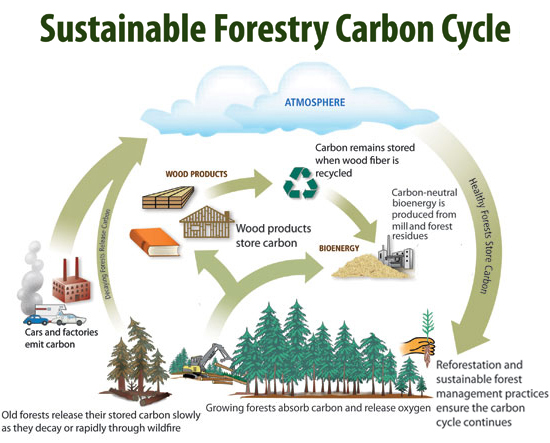Calculating Carbon Footprint
Active forest management, which includes thinning overly dense forests to reduce the severity of wildfires, helps to ensure that forests store more carbon than they release. Forest management activities aimed at accelerating forest growth also have the potential to increase the amount of carbon absorbed from the atmosphere, since young trees capture the largest amounts of carbon. The International Panel on Climate Change (IPCC) has stated: “In the long term, a sustainable forest management strategy aimed at maintaining or increasing forest carbon stocks, while producing an annual sustained yield of timber, fibre or energy from the forest, will generate the largest sustained mitigation benefit.”7
Whether trees are harvested and used for products or decay naturally, the cycle is ongoing, as forests regenerate and young trees once again begin absorbing carbon. But when trees are manufactured into products and used in buildings, a new phase of carbon mitigation begins.
Wood Buildings Store Carbon
Wood is comprised of about 50 percent carbon by dry weight.8 So the wood in a building is providing physical storage of carbon that would otherwise be emitted back into the atmosphere. For example, according to research organization FPInnovations, a 2,400-square-foot home with about 32 cubic meters of structural wood products is storing the equivalent of about 29 metric tons of carbon.
 |
|
Source: Tackle Climate Change—Use Wood |
In a wood building, the carbon is kept out of the atmosphere for the lifetime of the structure—or longer if the wood is reclaimed and reused or manufactured into other products. Wood stores more carbon than is emitted during its harvest, production, transport, and installation—even when transported over great distances.
In 2008, the amount of carbon stored in U.S. wood products (including those in landfill sites) was estimated at 3.5 billion metric tons—but the cumulative impact over time is much greater. The accumulation of stored carbon is about 60 million metric tons each year. Most of this resides in the nation's housing stock, 90 percent of which is wood-frame construction. Assuming that a greater number of homes and non-residential wood buildings are built each year than deconstructed, the amount of stored carbon can be expected to grow significantly.9 Put another way, continuously increasing the amount of carbon stored in U.S. buildings will provide significant mitigation of carbon emissions.









